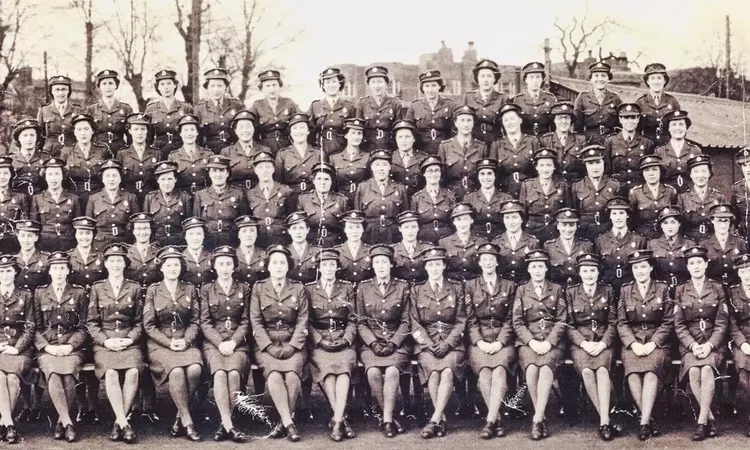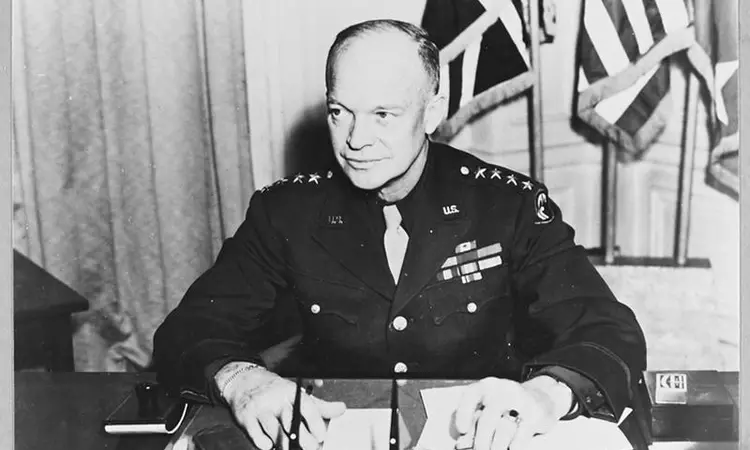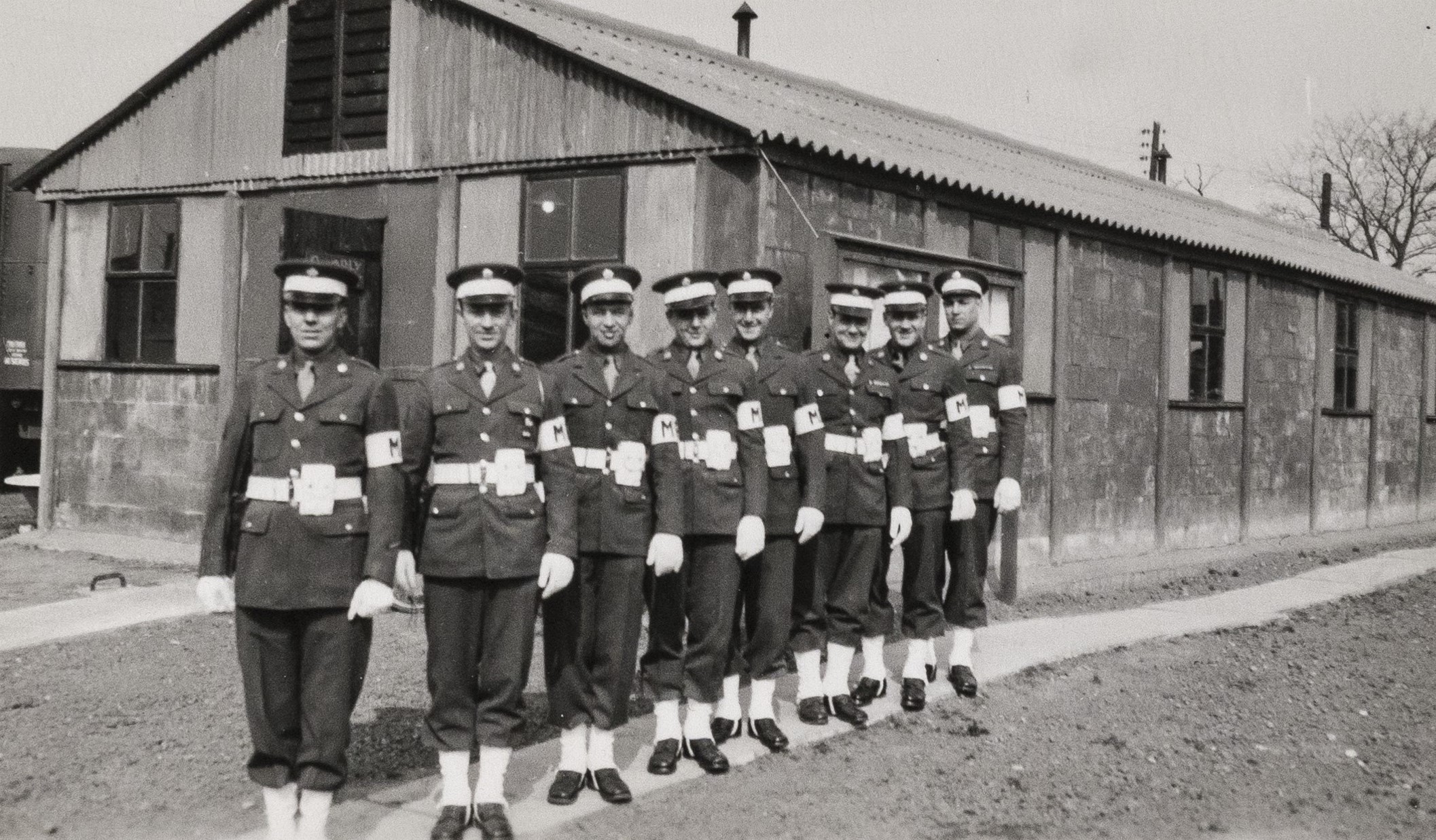
Setting up camp
When you visit Bushy Park today, nothing remains of the vast, bustling army and air force camp that used to be such a prominent feature of the park. It came to be known as Camp Griffiss, named after Lieutenant Colonel Townsend Griffiss – the first American officer to die in the European theatre of the Second World War.
Located just off Chestnut Avenue – near where SHAEF Gate is today – Camp Griffiss was a sprawling military encampment which housed the headquarters of the Eighth Air Force of the United States Army Air Force (USAAF). Codenamed ‘Widewing’, Camp Griffiss was home to thousands of service personnel who carried out vital work in air operations.
Later in the war, from 1944, Bushy Park also became home to the Supreme Headquarters of the Allied Expeditionary Force (SHAEF) under General Eisenhower, who were responsible for planning the critical D-Day landings of 6 June 1944.
But how did Camp Griffiss come to be in Bushy Park in the first place? How did over 3,000 American service personnel find themselves in the middle of one of London’s Royal Parks during the Second World War – and what were they doing there?
Discover more about Camp Griffiss and the vital role Bushy Park played in the Second World War with David Ivison, Trustee at the Friends of Bushy and Home Parks.
Bushy Park on the front line
There’s some debate about why Bushy Park was chosen as the location for the US Air Force and Army base. Some believe that the US base was originally intended to be based at Bushey in Hertfordshire and was constructed in Bushy Park due to an error.
Most likely, though, the park was selected for its distance from central London, which helped the camp avoid the worst of the bombing. The park also provided extensive space for the camp’s buildings and aircraft landing strip, which could all be relatively hidden amongst the trees and shrubbery.

Naming Camp Griffiss
Lieutenant Colonel Townsend Griffiss was the first American airman to die in the line of duty in Europe in the Second World War after the US entered the conflict. Camp Griffiss in Bushy Park was named in his honour.
His great-nephew, Townsend ('Tim') Alexander, takes great pride in his great-uncle's story. A military man himself, serving on active duty for 33 years in the US Navy and retiring as a two-star flag officer, Tim's family worked with The Royal Parks to bring Griffiss's story to light. Hear Tim's thoughts below on the legacy of his great-uncle and his special connection to Bushy Park.

Making preparations
The park underwent considerable change to make it a significant military base. It had four large brick office buildings named A, B, C and D, as well as a small airstrip located near where the playground is today. The park was equipped with anti-aircraft artillery, lookout posts and a bomb disposal unit.
To help hide the camp from the eyes of German planes, all the water bodies in the park were covered with camouflage nets. This included the Diana Fountain, Leg of Mutton pond and Heron pond.
Accommodation for troops included Nissen huts, which were made from sheets of steel bent into half a cylinder and placed into the ground. They were often cold and damp in the winter, heated by a single pot-bellied stove, and they overheated in summer when the metal grew hot under the sun. They can’t have been pleasant places to live and work for the American troops who were residents of the camp! By contrast, many of the officers were hosted by locals in the surrounding communities.

Explore Camp Griffiss
Click on an image and scroll through to discover what Camp Griffiss looked like.
Local people in the surrounding communities of Teddington, Hampton Court and Kingston were witnesses to something unusual – their local park being taken over by American troops. Let's discover what they thought about it!
The stories below have been taken directly from real testimonies of local people who remember Bushy Park during wartime.
Hear Roger's story
Hear or read the real story of a local named Roger, who lived near Bushy Park as a child during the Second World War.
‘I was just a lad of ten and along with my elder and younger brothers Bushy Park was our playground only living half a mile from it at the time. We always spent a lot of time in the park. Then the war came. Being so young we thought it was great at the time, only realising what hardship and sorrow it was later to bring once we had got into the war for real.
When we first heard that the Yanks were coming to Bushy Park everything seemed to happen so quickly. All the ponds and Diana Fountain were covered with camouflage about six feet above the water and the rafts which were used to hang the camouflage were left floating on the ponds. We had our own special man made holes in the camouflage and used these to get under the camouflage and spent hours messing about on the rafts floating about on the water, keeping fairly quiet in case there were any ‘parkys’ [park authorities] about.
However the most vivid memory was when the American women arrived, they were stationed in D Block and as there was a ten foot high wire fence all around the camp we had to crawl under the bottom strand of barbed wire in order to get in the huts with the ‘girls’ who would call us to come in to see them. They really liked our cute little accents and they would give us huge quantities of sweets and big tins of fruit and jam all sorts of things.
They were really overwhelmingly generous. They supplied us with so many goodies that were not available to us in the normal way.
It was worth taking the risk to creep under the wire when the guards weren’t looking.’

Hear Peter's story
Hear or read the real story of a local named Peter, who was employed as a carpentry trainee at Camp Griffiss as a teenager.
‘In April 1944 aged 14 years I managed with the help of my father to secure a job as a carpenter and joiner trainee, with a Teddington Building and Joinery Company called Kings.
I was ordered to report to...the General Foreman and Joinery Foreman at Camp Griffiss in Bushy Park.
...On the start day, 14th April, I cycled to the camp through a gate in Sandy Lane via Park Road, passing the women’s camp and reporting to a Mr. Styles. He took me to the workshop which was a large camouflaged hut. Outside I was shown zig zag slit trenches. As German Buzz Bombs were targeting the camp I was told that a siren would sound and if the bomber got close a voice over a loudspeaker would say danger take cover, if it got closer still the voice would say imminent danger take cover very rapidly. After the announcement you moved very quickly into the trenches.
As the new boy my job was to get the tea or coffee, this entailed going to the Cook House, speak nicely to the American Sergeant in charge. They were always very generous, tea and coffee was always on the go with plenty of sugar, milk, cream and sometimes cakes etc.
After a few days working there some of the Americans asked me to buy newspapers as I cycled through Kingston in the mornings. They mostly wanted the Daily Mirror, I think it cost 1 pence. Some paid on receipt but others said can we settle later. I was a little worried about this but Mr Thompson said not to as they would pay generously. He proved correct – they paid with cigarettes, chocolate, even silk stockings and tins of fruit.
...Although it was my first job and in wartime, looking back I enjoyed the time I spent in Camp Griffiss.’
Unless otherwise stated, images on this page come from the Bushy Park archive at The Royal Parks. We have made every effort to establish the provenance of the photographs and testimonies used in this exhibition, but if you have a query about any of these items please contact us at digitalcomms@royalparks.org.uk.
Discover more of our digital exhibition Operation Bushy Park
-

Life in Camp Griffiss I Bushy Park History
The men and women of Camp Griffiss worked hard – but they played hard too! The camp had much to offer when it came to leisure time.
-

The People of Camp Griffiss
Who were the people that lived and worked in camp? Let’s explore the stories of just some of the people who called Bushy Park home in the 1940s.
-

Planning D-Day
Discover the significance of D-Day and its ties to Bushy Park. Learn about Operation Overlord and Neptune's planning.
-

General Eisenhower in Bushy Park
Explore the pivotal role of General Eisenhower and his staff at the heart of Bushy Park in 1944, shaping history during the Second World War..
-

Bushy Park after the war
Discover the legacy of Bushy Park's wartime occupation, as we explore the Camp Griffiss Bushy Park site in the past, present - and future.
-

Operation Bushy Park: Plotting D-Day in a Royal Park
During the Second World War, Bushy Park was home to a sprawling military base. This is where General Eisenhower came to work on a top-secret plan...
Related Articles
-
 Read
ReadBushy Park's own 'Masters of the Air'
When you’re taking a walk through Bushy Park it can be hard to imagine that the park has a fascinating military past.
-
 Read
ReadJoe Louis at Bushy Park
Joe Louis is remembered as one of the first black sportsmen to transcend the colour barrier, and in WW2 he made a special appearance at Bushy Park.
-
 Listen
ListenHidden Stories of The Royal Parks: Parks at War
In this episode David Ivison, historical researcher for The Royal Parks Guild, explains how the Royal Parks were used during the two world wars.









